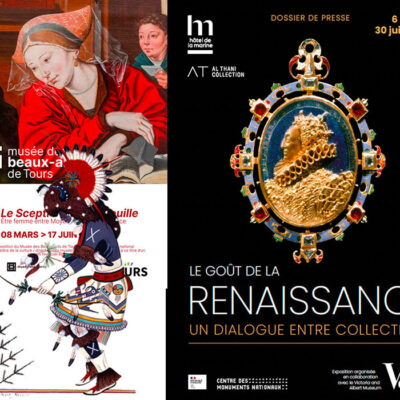My agenda
15 July 2024
Share
Jewelry in dialogue with contemporary design, at the Musée des Arts Décoratifs (Paris)
One hundred jewels have emerged from the storerooms to join the permanent collections in the contemporary design wing of the Pavillon de Marsan for a few weeks. A guided tour.
By Sandrine Merle.
The curators of the various departments of the Musée des Arts Décoratifs did not adopt a random approach in spreading their treasures in the 9 rooms spread over the 5 floors of the Pavillon de Marsan. But neither did they systematically opt for thematic integration. Together, they have woven links and correspondences with contemporary design based on free associations. Here are just a few of them.
7 reasons to go to the musée des Arts décoratifs
Level 5
In the introductory room
Twelve brooches and twelve rings by Jean Després are part of this room dedicated to Streamline, a 1930s American design movement inspired by the ocean liner. They also refer to mechanics, machines and speed (Després designed airplane engines during the First World War), and find numerous echoes. In Marc Newson’s 80s furniture, made of riveted aluminum sheets evoking a carlingue, or in Olivier Rousteing’s two Balmain carriage looks. Rousteing is fascinated by the United States, just like the founder, who was an excellent ambassador for French culture across the Atlantic.
In the “Memphis” room
“We wanted to show that Ettore Sottsass’s jewelry predates by 10 or 20 years the Memphis movement he founded in 1981,” explains Mathieu Rousset-Perrier, curator of the Middle Ages, Renaissance and Jewelry collections. His optimistic vocabulary (bright colors, playful, totemic shapes) can be found in architectural furniture such as Michele De Lucchi’s First chair, Michael Graves’ blue lacquered wood dressing table, inspired by New York skyscrapers, and Fred Sathal’s hairy gorilla dress from the 90s.
In the “Rêves et Fantaisies” room
Buttons and brooches in Swarovski crystals by Roger Jean-Pierre, one of the most important post-war paruriers, fit in perfectly with the theatrical, dreamlike and mixed-race works presented here. They respond to works by Emilio Terry, Janine Janet, Campana, Jonathan Creten (with a mirror featuring bizarre seaweed motifs) and Stéphane Rolland. The latter’s dress, in gold lamé cloqué fabric with gold leaf resin applications, responds to Daniel Roseberry’s contemporary horned dress for Schiaparelli. A designer with whom Roger Jean-Pierre made his debut in the ’30s.
Level 6
In the “Avatars of the vase” room
Here’s one of the rare thematic dialogues around the vase. The Australian Carlier Makigawa has worked this motif with whitened silver structures, mounted as necklaces. And we find it again on Issy Miyaké’s dress, in the folds of an Ingres painting-print: a naked woman holds a jar pouring water.
On level 8
In the Jean Prouvé room
Jean Prouvé’s recreation of a student room in Antony’s Cité Universitaire at the end of the 1950s houses six pendants by designer Jean Garçon for Dinh Van and Pierre Cardin. For the latter, he created the “masculine heart” and the “feminine heart”, one flat and geometric, cut out of a square, the other all curves and expressive volumes. “We saw it as the erotic dream of a student dressed in a suede Hermès jacket-suit, the men’s uniform in force until the 1970s”, Mathieu Rousset-Perrier laughs.
In the Charlotte Perriand room
It’s all happening in a dining room with integrated kitchen, based on Charlotte Perriand’s flagship Cité radieuse project in Marseille. The whimsy and brilliance of the chopped-lines jewelry of her contemporary Jean Lurçat (known for his tapestries with a revisited medieval atmosphere) provides a counterpoint to this “decorative art without decor”. “We pay tribute to their friendship: it turned out in retrospect that these two UAM members were close, shared the same political ideas and went to Moscow together. Here, affinities are also forged with Lucile Manguin’s deceptively sober dress (the pleating is complex) from 1937, a sliding-door sideboard designed for collector Maurice Jardot, and a lantern by Noguchi.
On level 9
In the “Poetic materials” room
Gilles Jonemann’s (godfather of contemporary jewelry) detour of ordinary materials such as pebbles and sandstone-like emu egg fragments into jewelry is right up there. So do the textured steel and concrete of Finnish artist Inari Kiuru, and the spiky, claw-like silver of Albert Duraz’s sculptural jewelry evoking a fantastic bestiary. All three transcend the material to create strange surfaces, shimmering colors and bewitching effects. Like Albert Elbaz’s masterful use of silk for Lanvin dresses that fly and float around the body. Or Rick Owens’ oiled leather garments.
It’s up to you to find other connections with contemporary design, of which there are many. And while you’re there, enjoy some of the best views in Paris, including the Sacré Coeur, the Opéra Garnier, the Champs-Élysées, the Eiffel Tower and the Grand Palais. Enjoy your visit.
“Parcours Mode Bijoux Design” at the Museum of Decorative Arts (Paris) – Until November 10, 2024

















